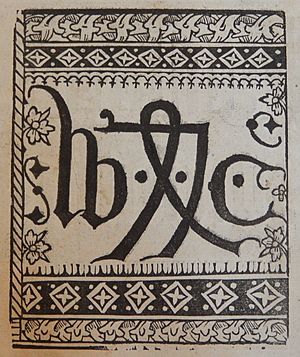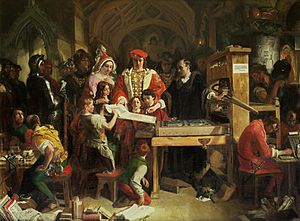William Caxton facts for kids
Quick facts for kids
William Caxton
|
|
|---|---|
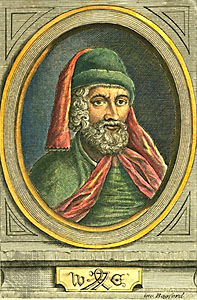 |
|
| Born | c. 1422 |
| Died | c. 1491 |
| Resting place | St Margaret's, Westminster |
| Occupation | merchant, diplomat, writer, printer |
| Period | Late Plantagenet, early English Renaissance |
| Notable work | Recuyell of the Historyes of Troye Dictes or Sayengis of the Philosophres |
William Caxton (born around 1422, died around 1491) was an important English merchant, diplomat, and writer. He is famous for bringing the first printing press to England in 1476. This made him the first English person to sell printed books.
Caxton's exact birth date and parents are not fully known. He was likely born between 1415 and 1424 in the Weald area of Kent, perhaps in Hadlow or Tenterden. In 1438, he became an apprentice to Robert Large, a rich London silk merchant.
After Large passed away, Caxton moved to Bruges, a wealthy city in Belgium. He settled there by 1450 and became very successful in business. He even became the head of the Company of Merchant Adventurers of London. During his travels, he saw the new printing industry in Cologne. This inspired him to start his own printing press in Bruges with Colard Mansion.
When Margaret of York, the sister of King Edward IV, married the Duke of Burgundy, they moved to Bruges. They became friends with Caxton. Margaret encouraged him to finish translating Recuyell of the Historyes of Troye, a collection of stories about the Trojan War. He finished this translation in 1471.
When Caxton returned to England, many people wanted copies of his translation. This led him to set up a printing press in Westminster in 1476. His first known printed book was Geoffrey Chaucer's The Canterbury Tales. He went on to print many other books, including adventure stories, classic works, and histories. He also translated Aesop's Fables in 1484. Caxton helped make the English language more standard across England through his popular translations.
In 2002, a BBC poll named Caxton among the 100 Greatest Britons.
Contents
William Caxton: England's First Printer
Early Life and Training
William Caxton's family likely included his parents, Philip and Dionisia, and a brother named Philip. However, some records suggest a different family in Suffolk. Another possible father for William was Thomas Caxton of Tenterden, Kent, who was also a merchant.
Caxton's birth date is not certain. Records suggest he was born between 1415 and 1424. This is based on when he started his apprenticeship in 1438. Apprentices usually began at age 14, but sometimes fees were paid late. In his first printed book, The Recuyell of the Historyes of Troye, Caxton said he was born and grew up in the Weald of Kent. Some towns like Tonbridge and Tenterden claim him as their own. A house in Hadlow, believed to be his birthplace, was moved in 1936 to Forest Row, East Sussex.
By 1438, Caxton was in London. Records show he began an apprenticeship with Robert Large. Large was a rich London merchant who sold luxury goods. He was also the head of the Mercers' Company and the Lord Mayor of London in 1439. When Large died in 1441, Caxton received a small amount of money, £20. Other apprentices received more, suggesting Caxton was not the most senior apprentice yet.
Printing in Europe
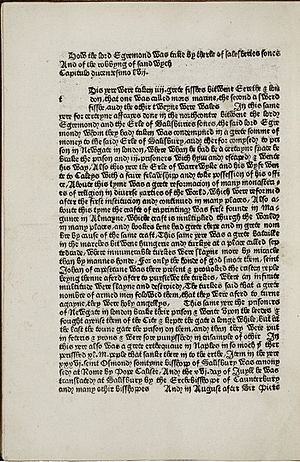
Caxton began traveling to Bruges by 1450 and settled there by 1453. He became very successful in business. He was even chosen as the governor of the Company of Merchant Adventurers of London. His work brought him into contact with the Duchy of Burgundy. Because of this, he became part of the household of Margaret, Duchess of Burgundy. Margaret was the third wife of Charles the Bold and the sister of two English kings, Edward IV and Richard III.
Being part of Margaret's household led Caxton to travel more in Europe. He visited Cologne, where he saw the new printing industry. German printing greatly influenced him. He quickly set up a printing press in Bruges with a Flemish man named Colard Mansion. The first book printed in English was made there in 1473. It was Recuyell of the Historyes of Troye, which Caxton himself had translated. In the book's ending, Caxton explained that his "pen became worn" and his "hand weary" from copying the book by hand. So, he "practiced and learnt" how to print it. His translation was very popular in the Burgundian court, and many requests for copies led him to start printing.
Bringing Printing to England
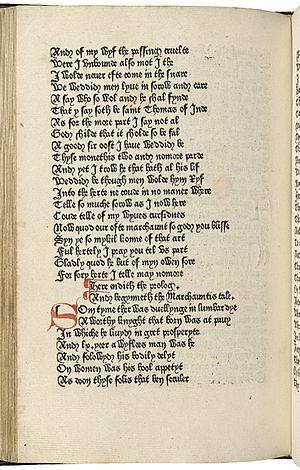
Caxton brought his new printing knowledge back to England. In 1476, he set up the country's first printing press in the The Almonry area of Westminster. The first book known to be printed there was an edition of Geoffrey Chaucer's The Canterbury Tales. Another early book was Dictes or Sayengis of the Philosophres (Sayings of the Philosophers). This book was printed on November 18, 1477, and translated by Earl Rivers, who was the king's brother-in-law.
Caxton's translations of the Golden Legend (1483) and The Book of the Knight in the Tower (1484) contain some of the earliest Bible verses printed in English. He also produced the first English translation of Ovid's Metamorphoses. His Golden Legend translation was based on a French version.
Caxton printed many types of books. These included adventure stories like Fierabras, and the very important Le Morte d'Arthur (1485) by Sir Thomas Malory. He also printed classic works and histories of England and Rome. These books were popular with the upper classes in England during the late 1400s. Caxton received support from noble and wealthy people, but he was not completely dependent on them. He might have also been paid by authors, like Lorenzo Gulielmo Traversagni, whose book Epitome margaritae eloquentiae Caxton published around 1480.
The John Rylands Library in Manchester has the second-largest collection of Caxton's printed works. The British Library has the largest. The Rylands collection has over 60 examples, with 36 complete and four unique copies.
Death and Memorials
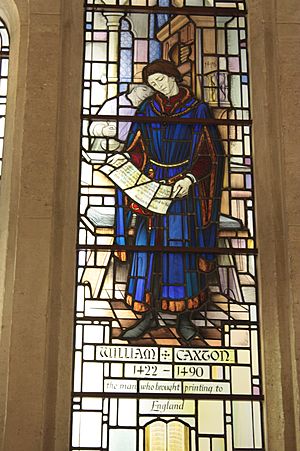
We don't know Caxton's exact death date. Records from his burial at St Margaret's, Westminster suggest he died around March 1492. However, some historians believe he died closer to autumn 1491. This is because the calendar used then meant March 24 was the last day of the year. Also, the number of books he printed in 1491 suggests he wasn't working for the full year.
In 1820, a memorial tablet for Caxton was placed in St Margaret's Church. This was done by the Roxburghe Club and its president, Earl Spencer.
In November 1954, a memorial to Caxton was revealed in Westminster Abbey. It was unveiled by J. J. Astor, who was the chairman of the Press Council. This white stone plaque is on the wall near the door to Poets' Corner. It says:
Near this place William Caxton set up the first printing press in England.
Caxton and the English Language
Caxton printed 80 percent of his books in English. He translated many works into English himself, doing much of the translation and editing. He is believed to have printed as many as 108 books, with 87 different titles. This includes the first English translation of Aesop's Fables on March 26, 1484. Caxton also translated 26 of these titles himself. His main goal was to accurately translate foreign texts into English. However, because he was often in a hurry and not a perfect translator, he sometimes just copied French words into English. This also led to some misunderstandings.
The English language was changing quickly during Caxton's time. The works he received to print were written in many different styles and dialects. Caxton was more of a technical printer than a writer. He often faced challenges in making the language standard in the books he printed. He wrote about these problems in the introduction to his Eneydos. His successor, Wynkyn de Worde, faced similar issues.
Caxton is given credit for helping to standardize the English language through printing. This means he helped to make regional dialects more similar. He mostly used the London dialect. This helped English vocabulary grow, made grammar rules more regular, and created a bigger difference between spoken and written English. Richard Pynson started printing in London in 1491 or 1492. He preferred what became known as Chancery Standard, which was based on the London dialect. Pynson was a more skilled writer than Caxton. He helped push the English language even further towards becoming standard.
It is thought that the spelling of "ghost" with the silent letter h was adopted by Caxton. This was likely due to the influence of Flemish spelling habits.
Caxton's "Egges" Story
In the 1490 edition of Caxton's translation of Virgil's Aeneid, which he called Eneydos, Caxton wrote about the difficulties of finding a standard English. He told a story about a boat sailing from London to Zeeland that got stuck. It landed on the Kent side of the River Thames.
A merchant from northern England, named Sheffield, went into a house. He asked the "good wyf" if he could buy some "egges". She replied that she could not speak French. This annoyed him, as he also could not speak French. Someone nearby suggested that Sheffield was asking for "eyren". The woman then said she understood that. After telling this story, Caxton wrote: "Loo what ſholde a man in thyſe dayes now wryte egges or eyren/ certaynly it is harde to playſe euery man/ by cauſe of dyuerſite ⁊ chaũge of langage" (meaning: "Look, what should a person write these days: 'egges' or 'eyren'? It is certainly hard to please everyone because of the different and changing language.").
See also
 In Spanish: William Caxton para niños
In Spanish: William Caxton para niños


